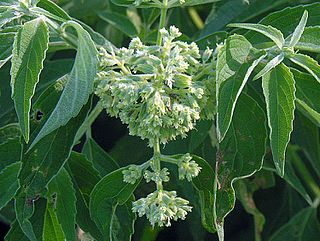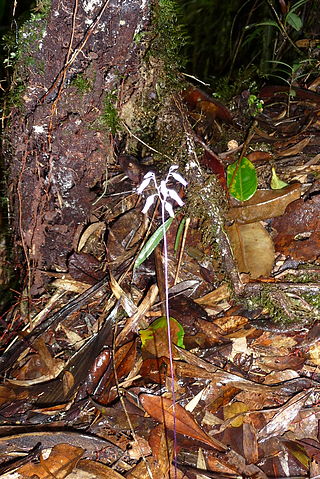
Psidium is a genus of trees and shrubs in the family Myrtaceae. It is native to warmer parts of the Western Hemisphere. Many of the species bear edible fruits, and for this reason several are cultivated commercially. The most popularly cultivated species is the common guava, Psidium guajava.

Pogonophora is a plant genus of the family Peraceae first described as a genus in 1854. It is native to central Africa and northern South America.
- Pogonophora letouzeyiFeuillet, 1993 - Gabon, Congo
- Pogonophora schomburgkianaMiers ex Benth., 1854 - Colombia, Venezuela, Guyana, Suriname, Fr Guinea, N + E Brazil
Mareya is a plant genus of the family Euphorbiaceae, first described as a genus in 1860. It is native to tropical western and central Africa.
Mareyopsis is a plant genus of the family Euphorbiaceae first described as a genus in 1919. It is native to western and central Africa.
- Mareyopsis longifolia(Pax) Pax & K.Hoffm. - Nigeria, Cameroon, Gabon, Equatorial Guinea, Congo-Brazzaville, Zaire
- Mareyopsis oligogynaBreteler - Gabon
Discoglypremna is a plant genus of the family Euphorbiaceae first described as a genus in 1911. It contains only one known species, Discoglypremna caloneura, native to tropical Africa.
Astrococcus is a genus of plant of the family Euphorbiaceae first described as a genus in 1854. It contains only one known species, Astrococcus cornutus, native to neighboring states of identical names, Amazonas State in southern Venezuela and Amazonas State in northwestern Brazil.
Haematostemon is a genus of plant of the family Euphorbiaceae first described as a genus in 1919. It is native to northeastern South America.
- Haematostemon coriaceus(Baill.) Pax & K.Hoffm. - Amazonas State in S Venezuela
- Haematostemon guianensisSandwith - Potaro-Siparuni region of Guyana

Maprounea is a plant genus of the family Euphorbiaceae first named as a genus in 1775. It is native to tropical Africa, Trinidad, and tropical Central and South America.
- Maprounea africana - W + C + S Africa, from Benin to Zimbabwe
- Maprounea amazonica - Colombia, Venezuela, N Brazil
- Maprounea brasiliensis - Brazil, Paraguay, Bolivia
- Maprounea guianensis - Trinidad, Panama, Colombia, Venezuela, French Guiana, Suriname, Guyana, Brazil, Peru, Ecuador, Bolivia, Paraguay
- Maprounea membranacea - Nigeria, Cameroon, Gabon, Equatorial Guinea, Cabinda, Central African Republic, Congo, Zaire
Pseudosenefeldera is a plant genus of the family Euphorbiaceae first described as a genus in 2001. It contains only one known species, Pseudosenefeldera inclinata, native to Panama and to northern and west-central South America.

Synsepalum is a genus of trees and shrubs in the chicle family, Sapotaceae described as a genus in 1852.

Renealmia is a plant genus in the family Zingiberaceae. Its members are native to tropical Africa and tropical America. In Peru, fruits and tubers are sources of indigenous dyes. and indigenous medical treatments for leishmania and malaria In Colombia, it is used to treat snakebite. Bracts and leaves can serve as phytotelmata, retaining small quantities of water that offer habitat for other organisms.
Eremospatha is a genus of climbing flowering plants in the palm family found in tropical Africa. These rattans are uncommon in cultivation and poorly understood by taxonomists. Closely related to Laccosperma, they are differentiated by the near complete absence of bracts and bracteoles. The name is from Greek meaning 'without a spathe'.

Lasimorpha is a monotypic genus of flowering plants in the family Araceae. It has the single species Lasimorpha senegalensis. This species is native to western and central Africa, from Liberia east to Chad and south to Angola.

Pleiocarpa is a genus of plant in the family Apocynaceae first described as a genus in 1876. It is native to tropical Africa from Senegal to Tanzania and south to Zimbabwe. As of August 2013 the World Checklist of Selected Plant Families recognises 6 species:
- Pleiocarpa bicarpellataStapf - Cabinda, Cameroon, Republic of the Congo, Gabon, Democratic Republic of the Congo, Kenya
- Pleiocarpa brevistylaOmino - Gabon
- Pleiocarpa muticaBenth. - Ghana, Ivory Coast, Liberia, Sierra Leone, Nigeria, Cameroon, Gabon, Central African Republic, Republic of the Congo
- Pleiocarpa picralimoides(Pichon) Omino - Cabinda, Republic of the Congo, Gabon
- Pleiocarpa pycnantha(K.Schum) Stapf - widespread across most of tropical Africa
- Pleiocarpa rostrataBenth. - Nigeria, Cameroon, Gabon
- Pleiocarpa camerunensis(K.Schum. ex Hallier f.) Stapf = Hunteria camerunensisK.Schum. ex Hallier f.
- Pleiocarpa hockiiDe Wild. - Acokanthera oppositifolia(Lam.) Codd
- Pleiocarpa simii(Stapf) Stapf ex Hutch. & Dalziel = Hunteria simii(Stapf) H.Huber

Englerophytum is a group of trees in the family Sapotaceae described as a genus in 1914.

Hoslundia is a genus of flowering plant in the family Lamiaceae, first described in 1804. It contains only one known species, Hoslundia opposita. It is widespread across much of sub-Saharan Africa including Madagascar.
Miersiella is a monotypic genus of flowering plants in the Burmanniaceae, first described as a genus in 1903. It contains only one known species, Miersiella umbellataUrb. It is native to South America.

Dictyostega is a genus of flowering plants in the Burmanniaceae, first described as a genus in 1840. It contains only one known species, Dictyostega orobanchoides, native to southern Mexico, Central America, Trinidad, and South America ).

Apteria is a genus of flowering plants in the Burmanniaceae, first described as a genus in 1834. It contains only one known species, Apteria aphylla, the nodding-nixie, native to the southern United States, Mexico, Central America, the West Indies, and South America.
Delpydora is a genus of plant in the family Sapotaceae described as a genus in 1897.











